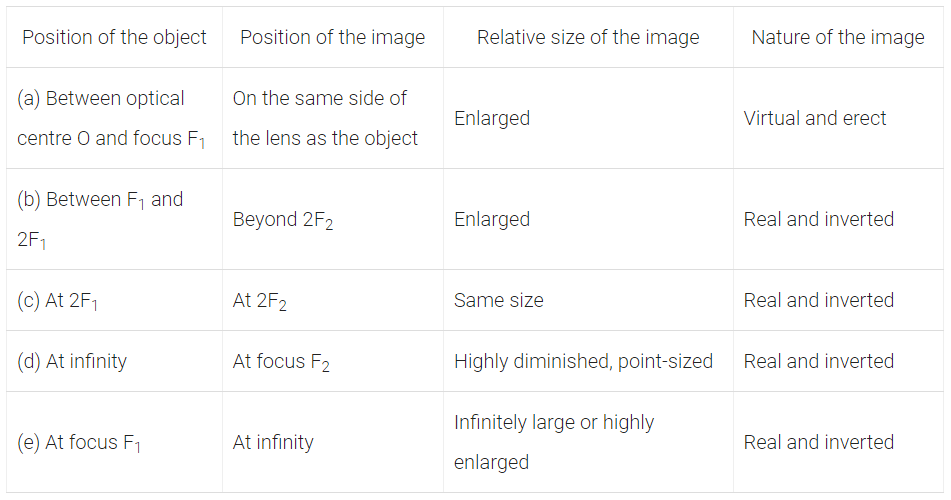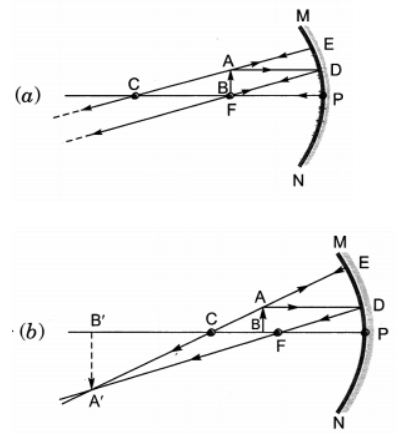Class 10 Science Chapter 9 Question Answers - Light - Reflection and Refraction
Q1: Write the laws of refraction. Explain the same with the help of ray diagram, when a ray of light passes through a rectangular glass slab.
Ans: Laws of refraction:
- The incident ray, the refracted ray and the normal at the point of incidence, all lie in the same plane.
- The ratio of sine of angle of incidence to the sine of angle of refraction is a constant, for the light of a given colour and for the given pair of media. This law is also known as Snell’s law of refraction.
If i is the angle of incidence and r is angle of refraction.
sin i / sin r = constant
Refraction through glass slab:
- The ray of light enters from rarer to denser medium at point O that is from air to glass and bends towards the normal.
- At ‘O’, the light ray enters from glass to air, that is, from a denser medium to a rarer medium. The light here bends away from normal.
- The emergent ray is parallel to the incident ray. However the light ray shifts slightly sideward.
- Refraction is due to change in speed of light when it enters from one medium to another.

Q2: Draw ray diagrams showing the image formation by a convex lens when an object is placed (NCERT Exemplar)
(a) between optical centre and focus of the lens
(b) between focus and twice the focal length of the lens
(c) at twice the focal length of the lens
(d) at infinity
(e) at the focus of the lens
Ans: Nature, position and relative size of the image formed by a convex lens for various positions of the object

Ray diagram for the image formation by convex lens:
 The position, size and the nature of the image formed by a convex lens for various positions of the object.
The position, size and the nature of the image formed by a convex lens for various positions of the object.
Q3: Draw ray diagrams showing the image formation by a concave mirror when an object is placed
(a) at the focus of the lens
(b) between focus and twice the focal length of the lens
(c) beyond twice the focal length of the lens
Ans: Image formation by a concave mirror for different positions of the object
Q4: Draw ray diagram for the image formation by a concave mirror.
Ans:

Q5: A spherical mirror produces an image of magnification -1 on a screen placed at a distance of 50 cm from the mirror.
(a) Write the type of mirror.
(b) Find the distance of the image from the object.
(c) What is the focal length of the mirror?
Ans: (a) Concave mirror
(b) m = -1, u = -50 cm,
∴ v = -50 cm
(c) 
∴ f = -25 cm
Q6: Draw a ray diagram to show the path of the reflected ray in each of the following cases. A ray of light incident on a convex mirror and concave mirror
(a) strikes at its pole making an angle θ with the principal axis.
(b) is directed towards its principal focus.
(c) is parallel to its principal axis.
Ans:

Q7: Explain the phenomenon of total internal reflection. Provide an example of its practical application and describe how it is used in everyday technology.
Ans: Total internal reflection is a phenomenon that occurs when a light ray traveling from a denser medium to a rarer medium strikes the boundary at an angle of incidence greater than the critical angle. In this case, the light ray is entirely reflected back into the denser medium, and no light is transmitted into the rarer medium.
Example and Application: A classic example of total internal reflection is the optical fiber. Optical fibers are used in various communication systems to transmit light signals over long distances with minimal loss of signal. The core of an optical fiber is made of a denser material with a high refractive index, surrounded by a cladding with a lower refractive index. Light entering the core undergoes multiple total internal reflections, which ensure that the signal remains confined within the core and travels without significant loss of intensity.
Practical Application: Telecommunication networks, including telephone lines and internet connections, utilize optical fibers to transmit data over vast distances. The phenomenon of total internal reflection allows for efficient data transmission in the form of light signals through the optical fibers, resulting in high-speed and reliable communication.
Q8: Describe the process of dispersion of white light. Explain how a prism disperses white light into its component colors and forms a spectrum.
Ans: Dispersion of white light refers to the separation of white light into its component colors when it passes through a medium that refracts different colors by different amounts. A prism is a classic example of a medium that disperses white light into its component colors, forming a spectrum.
Process of Dispersion and Spectrum Formation:
- White light consists of a mixture of colors with different wavelengths, each corresponding to a different color in the visible spectrum.
- When white light enters a prism, it undergoes refraction at both of its surfaces. However, the degree of refraction is different for each color due to their varying wavelengths.
- As a result, different colors deviate from their original path by different angles, causing them to spread out as they emerge from the prism.
- The colors arrange themselves in a specific order: red, orange, yellow, green, blue, indigo, and violet (ROYGBIV). This arrangement is called a spectrum.
Significance and Applications: The dispersion of white light and the formation of a spectrum are fundamental to various optical devices and phenomena. Examples include rainbows, the splitting of light in camera lenses, and the operation of spectrometers used in scientific research to analyze the composition of materials based on the wavelengths of light they absorb or emit.
Q9: Explain the concept of a lens and its types. Describe the difference between a convex lens and a concave lens, along with their respective characteristics and uses.
Ans: A lens is a transparent optical element that refracts light, causing it to converge or diverge. Lenses are classified into two main types: convex lenses and concave lenses.
Convex Lens:
- A convex lens is thicker in the center than at the edges.
- It converges parallel rays of light that pass through it, bringing them to a focus point called the focal point.
- Convex lenses are also known as converging lenses.
- They form real, inverted images when the object is beyond the focal point and virtual, upright images when the object is within the focal point.
- Uses: Convex lenses are used in various optical devices, such as cameras, binoculars, and magnifying glasses, to magnify objects and form images.
Concave Lens:
- A concave lens is thinner in the center than at the edges.
- It diverges parallel rays of light that pass through it, causing them to spread out as if they came from a focal point behind the lens.
- Concave lenses are also known as diverging lenses.
- They always form virtual, upright, and diminished images, regardless of the object's position.
- Uses: Concave lenses are used to correct myopia (nearsightedness) in eyeglasses and are also employed in devices such as microscopes and projectors.
The distinct characteristics and behaviors of convex and concave lenses make them valuable tools in various applications that involve focusing, magnification, and image formation.
Q10: Explain the phenomenon of atmospheric refraction. How does atmospheric refraction contribute to the apparent shape of the Sun during sunrise and sunset? Provide a detailed explanation.
Ans: Atmospheric refraction is the bending of light as it passes through the Earth's atmosphere. This phenomenon occurs due to the varying density of air layers in the atmosphere, which causes light to change its direction as it transitions from one medium (air) to another (vacuum).
Apparent Shape of the Sun during Sunrise and Sunset:
- When the Sun is close to the horizon during sunrise or sunset, its light rays pass through a thicker layer of the Earth's atmosphere near the horizon before reaching our eyes.
- Since air density increases with proximity to the Earth's surface, the lower layers of the atmosphere are denser than the upper layers.
- This denser air refracts (bends) the Sun's light rays upward, away from the Earth's surface, creating the illusion that the Sun is slightly above its actual position.
- As a result, the Sun appears higher in the sky than it would if there were no atmospheric refraction.
- Similarly, during sunset, atmospheric refraction causes the Sun to appear slightly higher on the horizon than its actual position.
Effect on Daylight Duration:
- Atmospheric refraction also contributes to the extension of daylight during sunrise and sunset. Because the Sun's rays are bent upward, we see the Sun before it has actually crossed the horizon. This causes daylight to start earlier in the morning and last longer in the evening.
While atmospheric refraction can lead to visual distortions, such as mirages, it plays a significant role in the apparent position of celestial objects and contributes to the beauty of sunrise and sunset views.





















